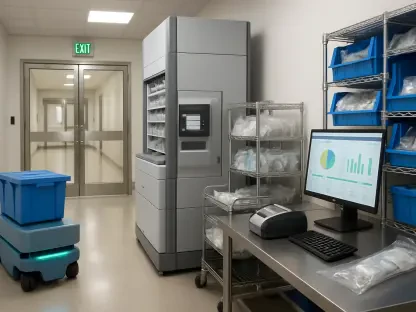In an era where wearable technology has become an integral part of daily life, a staggering reality emerges: millions of users track their heart rates, steps, and sleep patterns, yet struggle to make sense of the raw numbers flooding their smartwatch screens. This deluge of data often feels more like a puzzle than a pathway to better health. Imagine a tool that could not only decipher these metrics but also weave them into a meaningful story about one’s lifestyle—distinguishing, for instance, whether an elevated pulse signals an intense workout or a moment of anxiety. A groundbreaking innovation from a leading tech giant promises to bridge this gap, turning abstract sensor readings into actionable, humanized insights. This development marks a significant leap forward in digital health, offering a glimpse into a future where wearables do more than just track—they understand.
Revolutionizing Wearable Technology with AI
Decoding the Language of Sensors
The challenge of transforming raw smartwatch data into meaningful context has long been a hurdle in wearable tech. A new AI model, known as SensorLM, tackles this issue head-on by interpreting sensor inputs with remarkable precision. Trained on an unprecedented dataset comprising 59.7 million hours of data from over 103,000 individuals, this technology represents a monumental effort to align numerical readings with real-world activities. Unlike traditional systems that merely record metrics, SensorLM can discern subtle differences, such as whether a spike in heart rate comes from a brisk jog or a stressful meeting. This capability stems from advanced training techniques that allow the AI to pair sensor data with descriptive narratives, creating a bridge between cold numbers and human experience. The result is a tool that doesn’t just report data but offers clarity on what it means in the context of daily life, paving the way for users to make informed decisions about their well-being with ease and confidence.
Building a Foundation for Contextual Understanding
Underpinning SensorLM’s success is a sophisticated approach to learning that sets it apart from earlier models. Two key methods—contrastive learning and generative pre-training—enable the AI to differentiate between similar activities and produce human-readable summaries. Contrastive learning helps the model distinguish nuanced patterns, such as separating a casual swim from a rigorous weightlifting session, by focusing on the unique signatures of each activity. Meanwhile, generative pre-training equips the system to craft detailed explanations from raw data, turning a series of sensor readings into a coherent story of a user’s day. This dual strategy ensures that the technology not only identifies what is happening but also communicates it in a way that resonates with users. As a result, the vast dataset fueling SensorLM becomes a powerful resource for translating complex health metrics into insights that feel personal and relevant, fundamentally changing how individuals interact with their wearable devices.
The Future of Personalized Health Insights
Unmatched Performance in Real-World Scenarios
When put to the test, SensorLM demonstrates capabilities that far exceed those of conventional language models in the health tech space. In a challenging “zero-shot” evaluation—where the AI classified 20 different activities without specific prior training—it achieved exceptional accuracy, leaving other systems guessing at random. Beyond mere classification, this technology shines in its ability to generate precise event summaries from unprocessed data. For example, it can accurately narrate a sequence of events like an outdoor bike ride followed by a short walk and a restful sleep, complete with exact timings. This level of detail highlights a broader shift in digital health toward dynamic, tailored insights rather than static figures. Such advancements suggest that wearables equipped with this AI could soon serve as more than trackers; they could act as companions that provide a deeper understanding of personal health patterns, ultimately empowering users to take control of their wellness journey.
Scaling Toward a Conversational Health Coach
Looking ahead, the scalability of SensorLM points to an exciting evolution in wearable technology. Research shows that as the model expands and trains on increasingly diverse datasets, its performance continues to improve significantly. This trend hints at a future where smartwatches and similar devices could transform into sophisticated digital health coaches, clinical monitoring systems, or wellness applications capable of offering personalized advice through natural, conversational interactions. Imagine a device that not only tracks a morning run but also suggests recovery tips based on the body’s specific responses. This potential for growth underscores the model’s role as a pivotal advancement, moving beyond basic data collection to a profound comprehension of a user’s lifestyle and physical state. As this technology matures, it promises to redefine the relationship between individuals and their health data, making wellness guidance more intuitive, accessible, and uniquely tailored to each person’s needs.
Reflecting on a Health Tech Milestone
Reflecting on this transformative journey, the development of SensorLM stands as a defining moment in wearable technology. Its ability to decode the intricate language of smartwatch sensors and deliver accurate activity classifications alongside detailed summaries marks a significant departure from traditional data tracking. The shift toward personalized, conversational health tools is evident in every aspect of its design and performance. Looking forward, the next steps involve expanding access to such innovations, ensuring that more users can benefit from AI-driven insights. Continued investment in larger datasets and refined training methods is crucial to unlocking even greater potential. Additionally, integrating these advancements into everyday devices offers a practical path to enhancing global health literacy. This milestone reminds the industry that technology’s true value lies in its capacity to connect with users on a human level, turning raw data into a meaningful dialogue about well-being.









